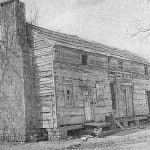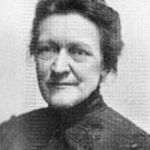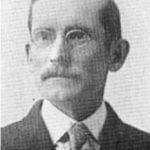
“I’ll go where you want me to go.”
The story of Oak Hill as an Industrial Academy begins with the work of Miss Eliza Hartford of Steubenville, Ohio, the first white teacher in the “Old Log house”. She was commissioned by the Freedmen’s Board in January, 1886, and was sent in response to the appeal of the colored people of the Choctaw Nation.
The missionaries, Reid and Edwards, had commended as the most favorable location for such an educational institution the rural neighborhood occupied by the Oak Hill Church, two miles east of Clear Creek in the valley of Red river.
They referred to this as a “pivotal location” for such a school, and wrote, “Here we want to see a good school established that shall grow into a normal academy. The location is central and healthful. If in charge of white teachers, such a school will attract scholars from all the other settlements.”
Heroic Pioneer

Oak Hill, like other schools of its kind, had its early period of heroic effort and self-sacrificing toil, before the usual comforts and conveniences of civilized life could be enjoyed. This was true of the entire period of service on the part of Miss Hartford, February 1886 to August 1888.
When she arrived at Wheelock, where she met a friend, Miss Elder, engaged in teaching the Indians, Rev. John Edwards served as an aid, in making a tour of inspection over the field, of which she was to be the missionary teacher and physician. This journey was made on horseback, which was the most speedy and comfortable mode of travel, over the rough and winding trails through the timber at that time.
As a result of this survey and a call at the home of Henry Crittenden, an elder of the Oak Hill Church and a “local trustee of the neighborhood, under the Choctaw law,” it was decided that the “old log house” was the best place to establish the school; and the best place for her to live was at the home of the colored elder, Henry Crittenden, three miles east. She was expected to make her daily journeys on horseback; and, in connection with the work of the school, to visit the people at their homes, furnish medicines for the sick and give instruction in regard to their care.
In her description of the old log house Miss Hartford states, “The windows are without sash or glass and the roof full of holes. The chimneys are of hewn stone, strong and massive. The house is of hewed logs, two stories in height and stands high in the midst of a fine locust grove. The well of water near it seems as famous as Jacob’s well.”
At the request of Mr. Edwards the colored people in the vicinity, after repairing the roof and windows, cleaned, scrubbed and whitewashed the inside of this old log house, and thus prepared it for its new and noble era of usefulness.
February 14, 1886
On Sabbath, February 14, 1886, one week after the arrival of Miss Hartford, her first meeting was held and a Sunday school was organized under her leadership. At its close a prayer-meeting was held in which she read the scriptures, the hymns and a sermon.
On Tuesday, February 16, 1886, the school was opened with seven pupils. The opening exercises consisted in the reading of a chapter by the new teacher, the singing of a hymn and prayer by elder Henry Crittenden. The latter was profoundly impressed with the fact that, in the auspicious opening of the school that morning, the colored people of that section were realizing the answer to their oft repeated prayers, the fulfillment of their long delayed hopes.
The new teacher had never heard such a prayer in any school she ever attended. He thanked Our Heavenly Father, “That the prayers of his people were answered. In their bondage they had cried unto Him and He had heard their cry. In their ignorance and darkness they had asked for light and the light had come.” He prayed for the teacher that “God would give her wisdom and enable her to be faithful.” He prayed for the children and their parents that, “they might be able to see and appreciate what God had done for them,” and for the school, “that it might abide with them and become an uplifting power to them and their children.”
On the following Monday the number of the pupils had increased to fourteen. The chills were prevalent and frequently half the pupils would be seen huddling around the log fire in the chimney fireplace, and making a chattering noise with their teeth.
A Boarding School
On April 15, 1886, Miss Hartford began to live at the school building and some of the pupils brought their corn-meal so they might live “wid de teacher,” and Oak Hill became a boarding school with an enrollment of 24 pupils.
At a prayer meeting of the women held soon after this event, it was decided to build a kitchen at the west end of the log house so “de chillen might have a place to bake and eat their corn bread.” While they were building this kitchen a man who saw them said to Miss Hartford, “It makes the men feel mighty mean to see the women doing that work.” She repeated to him the following words from the third verse of the fourth chapter of Paul’s epistle to the Philippians: “I entreat thee also, true yokefellow, help those women which labor with me in the gospel, whose names are in the book of life.” The result was very gratifying. He got his team, hauled the rest of the materials and then helped them to complete it. This improvement increased the facilities and also the general interest in the school.
In September 1886 pupils began to arrive from distant places and whilst some of them were retained in the building others were located among the friends in the neighborhood. In February following, all the available room in the log house was occupied and the work of the school proving too great for one teacher, another one was requested. The institution had now acquired the name, “Oak Hill Industrial School.”
Priscilla G. Haymaker

In April 1887, Miss Priscilla G. Haymaker, of Newlonsburg, Westmoreland County, Pennsylvania, arrived to aid in the management of the school, and this event was the occasion for another thanksgiving on the part of the people. At a meeting then held they decided to build a house that could be used for a school house and chapel, using the materials in the Oak Hill school building of 1878. The men agreed to donate all the work they could, and, with ox teams, delivered the lumber in the old building. The Board gave $50.00 and Rev. John Edwards $25.00 towards the purchase of new lumber. It fell to the lot of Miss Hartford and Elder Henry Crittenden to pay some of the balances due on this building, and their contributions were remarkably large ones for those early days.
Miss Hartford, at the time this building was undertaken, was given special permission to solicit money to furnish the new school building, to fit up the “old log house” for a boarding house, and scholarships of $15.00 each. She went east and returning in August found the new building ready for the desks.
Miss Haymaker solicited and received the promise of a large bell that had been used by her father on the old farm at Newlonsburg, Pa., that the people might rejoice over the possession not merely of a chapel and school building, but one “wid a bell.”

The time appointed for opening the fall term was now near at hand and yet the old log house was not ready for the boarders that were expected soon to fill it, owing to the fact no workmen could be found to do the work. Miss Hartford and Miss Haymaker, with the help of a boy, made the bedsteads and tables with their own hands, the latter manifesting considerable skill in the use of the saw and hammer. On September 1st the boarders began to arrive and on the 15th, 60 pupils were enrolled of whom 36 were boarders. Every boarder was expected to bring 12 bushels of corn, and with scholarships of $15.00 each, there was no danger of starving. The girls were required to do the housework and the boys to provide the wood. Miss Haymaker was not used to roughing it and before the close of November she was compelled to return to her home, broken in health.
Anna E. Campbell
Miss Anna E. Campbell of Midway, Pennsylvania, who had previously been sent for, arrived at Oak Hill two days after the departure of Miss Haymaker, and with her the long expected bell, from the old home of the latter. The following Sabbath, the first one on which they were called together for worship by the clarion tones of the new bell, was another glad day for the people, and they extended to Miss Campbell a very cordial welcome, as the new assistant of Miss Hartford. She remained until the end of the term, June 15th, 1888.
Miss Campbell held temperance meetings every Saturday and some objected to them, because “dey was teachin de risin generashun dat it was wrong to drink whiskey or use tobacco, while de Bible said it was good for de stomik.” During this second term six of the pupils, repeated the Catechism and nine united with the Church.
During the summer of 1888 Miss Hartford remained alone to take care of the homeless children, and maintain the Sunday school and prayer meeting. Other parents began to call and plead for room for their children. Believing the time had come when another and a larger building was necessary in order to receive them, she rode a long distance to confer with a carpenter, in regard to the erection and cost of a frame building for boarders. He arranged to call and make an estimate, but while she waited for him, her health began to fail. The exposures, burdens and privations proved too great for her, single handed and alone, and she felt constrained to return to her home. She was unable to return to Oak Hill and died at Richmond, Ohio, July 9, 1901. Miss Campbell was also unable to return and the school was left without a teacher.

